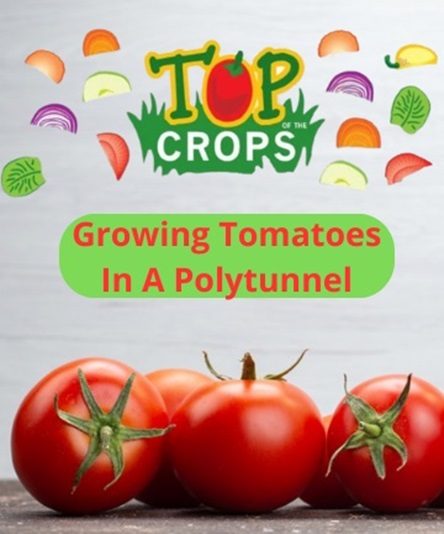Welcome to the Top of the Crops. Today, you will learn everything that there is to know about growing tomatoes in a polytunnel!
Tomatoes are, of course, one of the most popular crops for home growing – they are a staple summer crop for many polytunnel growers.
The tomato, Solanum lycopersicum, is widely grown throughout temperate regions. The plant is a cultivated form of a wild ancestor that is native to South America.
The tomato is believed to have been first domesticated by the Aztecs and other Mesoamerican people and the Spanish first brought them back from the 'new world' to Europe during the period known as the Columbian Exchange.
There are two main types of tomatoes – determinate types, also known as bush tomatoes, and indeterminate types, also known as cordon tomatoes. One key thing to understand when growing tomatoes is the difference between these two types and their care, so you need to know which of these two types you are growing in order to do so successfully.
Choosing the right tomato for your garden is key, and that means choosing not only the right type, but also selecting the right cultivars for your location, needs and wishes. There are of course numerous hybrid and heritage or heirloom tomato varieties to choose from:
| Jan | Feb | Mar | Apr | May | Jun | Jul | Aug | Sep | Oct | Nov | Dec | |
| Sow |  |
 |
 |
|||||||||
| Plant |  |
 |
||||||||||
| Harvest |  |
 |
 |
 |
When growing tomatoes, the most important things to understand are the conditions that these plants require throughout each of their stages of growth, and how you can keep them happy and healthy throughout the growing season.
Tomatoes can differ in their time to harvest and some of their basic needs depending on which variety of varieties you have chosen to grow. Larger beefsteak type tomatoes will typically have a much longer time to harvest than smaller cherry tomatoes.
In the UK, we have a relatively short growing season and so it can often be easier to grow tomatoes with a shorter time to harvest, especially if we are growing tomatoes outdoors.
The key things to remember is that all tomato plants need:
A location that is as warm, sheltered and sunny as possible. Tomatoes prefer a temperature of 21 - 24°C and will perform poorly at temperatures above 27°C or below 16°C.
Full sun, ideally with a south or west facing aspect.
A moist yet free draining, fertile soil or growing medium rich in organic matter.
Consistent watering throughout the growing season.
Feeding with a potassium rich organic liquid feed during the flowering and fruiting period.
Bush tomatoes may sometimes need support, but cordon types will always also require some structure to which they can be tied in as they grow.
Using a polytunnel or greenhouse will make it a lot easier to successfully grow tomatoes here in the UK, and will expand the number of varieties you are able to grow by prolonging the growing season.
Polytunnels or greenhouses also make it easier to grow tomatoes because tomatoes are a crop that requires relatively high temperatures to thrive – ones that it is not always easy to provide when growing outdoors across much of the UK. A long, hot summer is ideal for tomato cultivation. You could even try growing these in our exclusive fruit cages.
What you will require to grow tomatoes depends in part on where and how you have chosen to grow your tomatoes and where precisely you are growing them.
In general, however, you will need:
Tomato seeds or young transplants.
Seed trays, small pots or soil blocks in which to sow your seeds when not direct sowing. And perhaps grow lights and a heated propagator when starting tomatoes indoors early in the year.
Containers of some kind such as pots or grow bags if growing in a container garden, or a suitable raised bed or in ground growing area where the right conditions for tomato plants can be provided.
A means to water/ irrigate your tomato crop.
Organic mulch materials and liquid plant feed to keep tomato plants in tip top health.
As mentioned above, a greenhouse or polytunnel, or cloches or mini tunnels where space is limited can also be beneficial and will make it easier to grow tomatoes in the British Isles. And for many tomatoes, including all cordon types, support structures will be needed.
A simple process can guide you through tomato cultivation. Here are the key steps to follow if you want to grow tomatoes in your garden.
Choose which tomatoes to grow and source your seeds.
Sow your tomato seeds indoors between February and the end of April.
Pot on tomato seedlings to their own individual pots once they are large enough to handle.
Transplant the tomatoes to their final growing positions around the time when the first flowers open, and when the conditions are warm enough for the plants to thrive. Remember to harden off indoors sown tomato plants before placing them outdoors.
Mulch around your tomato plants and add companion plants for highest yields and best results.
Pinch out side shoots on cordon tomatoes but this is not necessary on bush types.
Water consistently, well and deeply each time to avoid shallow rooting.
Feed tomatoes with a potassium rich feed once a fortnight or so.
Tomatoes should be ready to harvest from July onwards, typically up until the first frosts.
Rotate crops in a three or four year rotation – don't grow tomatoes in the same location on subsequent years.
When precisely you should sow tomatoes depends on where you plan on placing those tomatoes. If you are growing them in a greenhouse or polytunnel, it is best to sow in February or early March, while it is generally best to leave it a little later to sow if you will be growing your tomatoes outside.
Sow seeds into seed trays, small pots or soil blocks with seed starting compost. Ideally use a heated propagator to keep temperatures around 18°C. for best germination.
As soon as the seedlings appear, make sure they are in as light and bright a spot as possible, either under grow lights or in a sunny window. This helps to prevent the legginess which can become an issue, especially with the earliest sowings.
Once the tomato seedlings are large enough to handle, prick these out and pot each one on into its own individual pot or soil block with a good quality multi-purpose potting mix or a homemade equivalent.
Bury the small seedlings up to their first pair of leaves. And keep them in as bright a location as you can, where the temperatures are at least 16°C..
Water regularly but take care not to create waterlogged conditions. After around a month they will usually be ready to transplant into their final growing positions.
Harden off and plant out your tomatoes, either into their final containers or into the ground or a raised bed that you have prepared.
You need to know how far apart to plant tomatoes.
As a rough guideline for tomato spacing, two tomatoes can be placed in a grow bag, or one per pot when pots are around 30-45cm in diameter. In the ground, tomato plant spacing differs. You can place one tomato plant per square foot, or space plants in rows 45-60cm apart depending on the tomato varieties and type.
Remember, the key elements of care when growing tomato plants are:
watering
feeding
support and pruning
Water tomatoes deeply and consistently throughout the growing season. Try to water the ground at the base of the plants and avoid, where possible, splashing water on the foliage, flowers and fruit, as this can increase the chances of certain diseases taking hold. Reduce then stop watering to encourage green tomatoes to ripen at the end of the growing season.
Mulch around tomato plants upon planting with an organic mulch. Feed every couple of weeks with an organic liquid plant feed while the plant flowers and fruits form.
Tie in cordon types and bush types if required as they grow, to a suitable support structure. With cordon types, you should remove side shoots that form regularly. With bush types, side shoots don't need to be removed and doing so will reduce the number of fruits you get.
Harvest tomatoes when they have fully ripened on the vine for best flavour. How they will look will of course depend on the variety or variety you have chosen. Pick the fruits when they are fully coloured, plump and glossy. Remember, the time of harvest may vary with the variety, and will also vary with the weather in a given year.
Tomatoes picked a little early will continue to ripen indoors in a warm and dark spot, and ethylene gas (from other ripening fruit) will speed up the process. But tomatoes will always taste best when they can ripen fully on the plant. There are ways to encourage green tomatoes to ripen.
Tomatoes are at their best fresh from the garden, soon after you have harvested them. But tomatoes can be kept in the fridge for around a week if necessary, or cooked and frozen, dried, or canned/ bottled in order to preserve them for later use. You should find that there are plenty of ways to use a glut of tomatoes from your garden.
BBC Gardener's Magazine (2022) Sweetest Tomatoes To Grow. Gardeners' World. [online] Available at: https://www.gardenersworld.com/plants/five-sweetest-tomato-varieties/ [accessed 13/12/23]
Waddington, E., (2023) 17 Yellow & Orange Tomato Varieties. Horticulture. [online] Available at: https://horticulture.co.uk/tomatoes/yellow-orange-varieties/ [accessed 13/12/23]
BBC. (n.d.) Tomato Recipes. BBC Good Foods. [online] Available at: https://www.bbcgoodfood.com/recipes/collection/tomato-recipes [accessed 13/12/23]
